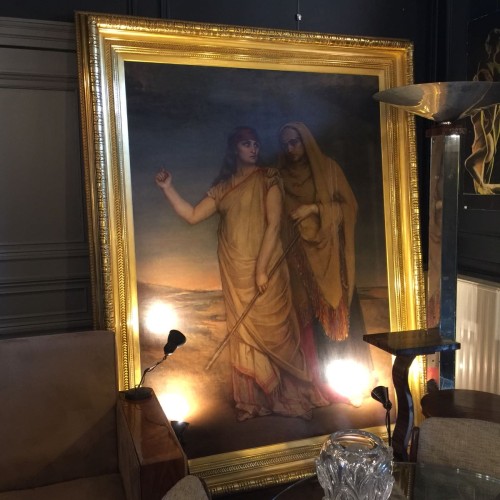Creator / Artist / Designer:Attributed to Jean-François Portaels (1818 - 1995)
Period:19th Century
Price:on request
Country of Origin:Belgium
Dimensions (H x W x D):200cm x 150cm x 20cm
Weight:50 Kg
Number of components:1
Condition:Excellent
Style:Orientalism, Realism, Symbolism
Materials:Oil/canvas, Golden stuccoed wood
Museum work "Ruth and Naomi" attributed to Jean-François Portaels presented in its exceptional original frame stuccoed and gilt leaf.
State of conservation remarkable.
Dimensions with frame: 240 x 190cm.
Jean-François Portaels studies at the Brussels Academy with François-Joseph Navez. To improve himself, he attended the classes of Paul Delaroche in Paris, and in 1842 won the Grand Prix de Rome. Portaels spent some years in Italy with his friend, the painter Alexandre Robert. They then went to the East, between 1845 and 1847.
Painter of historical and orientalist scenes and religious compositions, Portaels is also a portraitist and paints mainly in oil. He is wrongly considered as the founder of the Belgian Orientalist school. he will draw inspiration from the sketches he made during his travels, which is why he is often credited as a precursor of Belgian Orientalism. In 1847 Portaels was appointed director of the Ghent Academy.
Portaels made a free workshop in 1858, where he received many artists. This workshop made so much shade at the Brussels Academy that its director entrusted him with composition courses in 1863.
He went to Morocco in 1874 and brought back a large amount of sketches, which allowed him to revive his Orientalist inspiration.
In 1878, Portaels became director of the Royal Academy of Fine Arts in Brussels. He exerted an important influence on the next generation of Belgian painters, including Alfred Bastien, Théo van Rysselberghe, Emile Wauters, Edouard Agneessens and Marie Antoinette Marcotte, the sculptor Charles Van der Stappen and the architect Charles Licot.
He can be considered as a transition painter between neo-classicism of Navez and the romanticism of Wappers.
